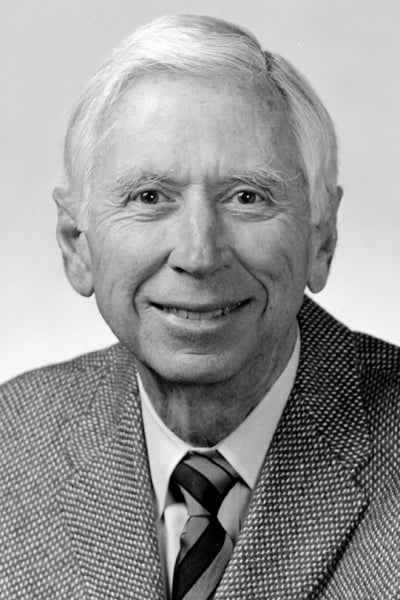Donald A. Dunn, professor emeritus at the Stanford School of Engineering, died at Stanford Hospital on Sept. 27 after a long illness. He was 85 years old.
Dunn was a passionate teacher and innovator. In the 1960s, he helped form Stanford’s Department of Engineering–Economic Systems (EES), which applied engineering systems methods and economic analysis to policy and decision making, both in government and industry.
Dunn served as a professor and associate chair of EES for many years, retiring in 1995. His early publishing was in physics and electronics, including microwave electron tubes, microwave power systems and computer simulations of plasmas. More recently he published in areas of systems engineering, satellite and computer communication, and telecommunications public policy.
Born and raised in Southern California, Dunn attended South Pasadena–San Marino High, taking chemistry courses at Pasadena Junior College. In 1943, the Navy began enrolling officer candidates in its V-12 college training program. Dunn was admitted to Caltech, where he studied chemistry with Nobel laureate Linus Pauling and history with J. E. Wallace Sterling. He completed his naval service aboard a light cruiser and then came to Northern California to work for the electronics company Eitel-McCullough, where he eventually served as director of research.
Dunn next attended Stanford Law School, where he won the first Hellman Legal Writing Prize. Just prior to starting law school, Dunn met Jane Goodspeed, a graduate of the Stanford School of Education and a teacher at Palo Alto High School. They were married in 1948. He received his law degree in 1951. He practiced before the U.S. Patent Office and as an attorney with the firm of Flehr and Swain in San Francisco and, later, for Hughes Aircraft in Los Angeles.
While in law school, Dunn also worked in the tube lab at the Stanford Electronics Research Lab (ERL), and in 1956 he earned a PhD in electrical engineering at the Stanford School of Engineering, studying under the legendary Fred Terman. Dunn went on to become director of the Electron Devices Laboratory at Stanford and director of the Stanford Plasma Physics Laboratory.
He was a pioneer in the field of microwave tube research, working with Dean Watkins, Hubert Heffner, Lester Field, Ed Ginzton, Karl Spangenberg and Marvin Chodorow.
He was chair of the International Symposium on Microwave Power held at Stanford in 1967 and a member of the board of governors of the International Microwave Power Institute from 1966 to 1968. In 1970 he co-authored a book on the future of satellite communications, and in 1972 he wrote Models of Particles and Moving Media. He was a senior member and former chair of the San Francisco section of the Institute of Electrical and Electronics Engineers.
Dunn was also an expert on the interdependence of computers and communications and spoke to a congressional gathering in 1969 about telecommunications policy. In 1976, in an interview in Computerworld magazine, Dunn boldly predicted that online users would blossom from 500,000 to 50 million in coming years. Later, he served as an expert witness during the AT&T breakup case.
In Stanford’s EES department, Dunn was an enthusiastic and inspirational teacher. Teaching was a crucial aspect of his life. He traveled widely both as a professor and consultant, often with his family. He particularly enjoyed visiting his graduate students in their home countries.
Upon his retirement, Dunn spent time at the beach in Aptos. He continued to write and to advise students, and maintained a 40-year ritual of neighborhood runs and daily swims at DeGuerre Pool.
He is survived by his wife of 63 years, Elizabeth Jane Dunn; his children, William Goodspeed Dunn and Dr. Elizabeth Ross Dunn; his son-in-law, Dr. Richard Johansson; and two grandchildren, Liam and Willem Johansson.
At Dunn’s request, there will be no service. A celebration of his life for colleagues, friends and family is planned for a later date. In lieu of flowers, memorial gifts in Dunn’s name may be made to the Department of Management Science and Engineering at Stanford University.
